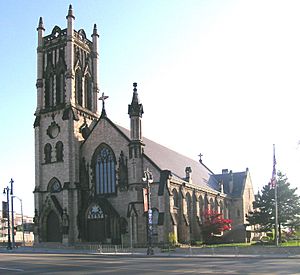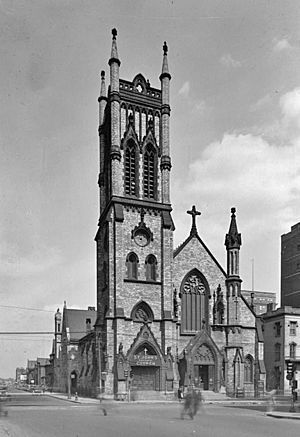St. John's Episcopal Church (Detroit) facts for kids
Quick facts for kids St John's Episcopal Church |
|
|---|---|
 |
|
| Denomination | Episcopal Church |
| Churchmanship | High Church |
| Website | www.stjohnsdetroit.org |
| History | |
| Dedication | Saint John the Apostle |
| Administration | |
| Diocese | Episcopal Diocese of Michigan |
| Province | V |
St. John's Episcopal Church is a very old church in Downtown Detroit, Michigan. It is located at 2326 Woodward Avenue. This church was built before the American Civil War. It is the oldest church still standing on Woodward Avenue. This area was once known as Piety Hill because it had many religious buildings.
St. John's Episcopal Church was added to the National Register of Historic Places in 1982. This is a list of places important to American history. It was also named a Michigan State Historic Site in 1987.
Contents
The Church's Story: A Look Back in Time
The St. John's church community started in Detroit in 1858. A big reason for its creation was the hard work of Henry Porter Baldwin. He was a very successful businessman. Later, he became the governor of Michigan and a United States senator.
Mr. Baldwin bought the land for the church and gave it as a gift. This land was on the edge of Detroit at the time. He also gave money to build a rectory, which is where the church's priest lives. He also funded a small chapel that could seat 150 people. These buildings were designed by architects Jordan & Anderson.
Growing Pains: A New Church is Built
The chapel was finished in 1859. However, the church community was growing very fast. The chapel quickly became too small for everyone. So, a new, larger church building was planned by Jordan & Anderson. It was built quickly and officially opened on December 10, 1861.
Traditions That Last
Today, the church community at St. John's is special. Unlike many modern Episcopal Churches, it uses a very traditional prayer book. This book is the 1928 edition of the Book of Common Prayer. Some services during the week even use the Anglican Missal, which is an even older form of worship.
Exploring the Church's Design
St. John's Church is a great example of Victorian Gothic Revival architecture. This style looks like old European cathedrals. The church building is 170 feet long and 65 feet wide. The tallest part is the bell tower, called a belfry, which reaches 105 feet high.
Building Materials and Details
Most of the outside of the church is made from rough limestone. The decorative parts are made from a smoother stone called Kelly Island sandstone. Strong supports called buttresses help hold up the side walls and the roof. The roof is also supported by special wooden beams called hammer beam trusses. You can see decorative stone carvings, called gargoyles, along the roofline. There are also fancy stone frames, called hood moldings, above the windows and doors.
Inside the church, there are balconies on three sides. These balconies, or galleries, stick out without pillars underneath them. This design made the church feel very open, like an auditorium.
Beautiful Stained Glass and Furnishings
There are six beautiful stained glass windows on each side of the main part of the church, called the nave. These windows were put in between 1880 and 1954. The very top parts of the windows still have the original clear and colored glass. A large, impressive window at the west end of the church was added in 1963.
The altar, which is the table used for services, was installed in 1873. It is made of white Caen stone. This altar was given in memory of the mother of the church's leader, Rector George Worthington. Many other items in the front part of the church, called the chancel, were also given as memorials during changes made in 1892. These include a screen made of wrought iron and Caen stone, a matching pulpit for speaking, and a brass lectern for reading. Hand-carved oak seats for the clergy and choir were added after more changes in 1936.
Changes Over the Years
St. John's Church has had two major changes to its design since it was built. The first change happened in 1892. The chancel area was made deeper to create more space for the organ and the choir. To do this, the original chapel had to be taken apart and rebuilt ten feet further to the east.
The second big change happened in 1936. Woodward Avenue was being made wider, so the entire church and chapel had to be moved. They were carefully moved 60 feet backward from their original spot.
The oldest part of the church, the chapel, is still standing today. It also has several beautiful stained glass windows. A special historical marker from the State of Michigan now stands at the church, telling its story.
See also
 In Spanish: Iglesia Episcopal de San Juan (Detroit) para niños
In Spanish: Iglesia Episcopal de San Juan (Detroit) para niños



